Nursing Assignment | Construction of Care Plan
VerifiedAdded on 2022/07/29
|7
|2339
|41
AI Summary
Contribute Materials
Your contribution can guide someone’s learning journey. Share your
documents today.

Running head: NURSING
Nursing
Name of the Student
Name of the University
Author Note
Nursing
Name of the Student
Name of the University
Author Note
Secure Best Marks with AI Grader
Need help grading? Try our AI Grader for instant feedback on your assignments.
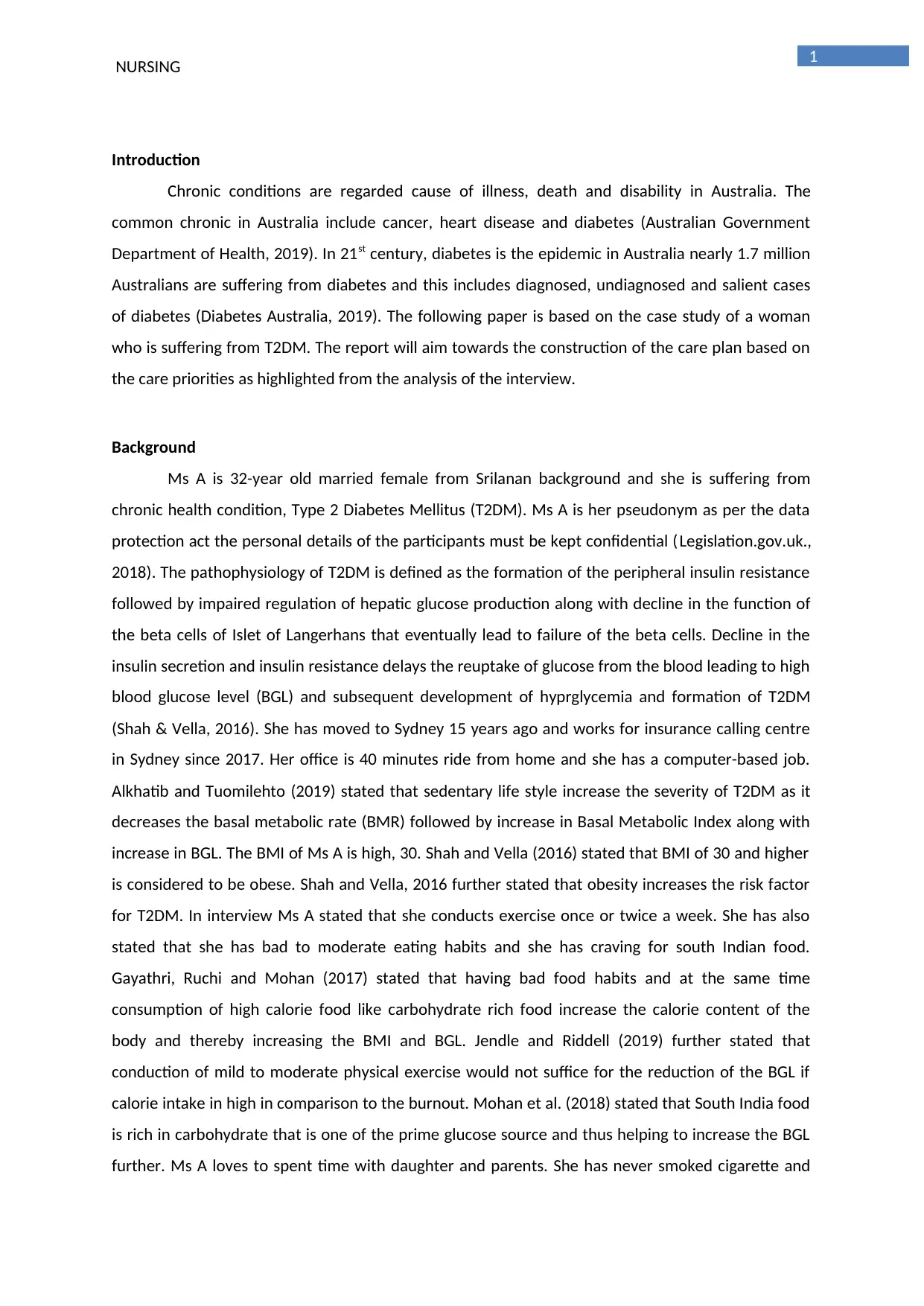
1
NURSING
Introduction
Chronic conditions are regarded cause of illness, death and disability in Australia. The
common chronic in Australia include cancer, heart disease and diabetes (Australian Government
Department of Health, 2019). In 21st century, diabetes is the epidemic in Australia nearly 1.7 million
Australians are suffering from diabetes and this includes diagnosed, undiagnosed and salient cases
of diabetes (Diabetes Australia, 2019). The following paper is based on the case study of a woman
who is suffering from T2DM. The report will aim towards the construction of the care plan based on
the care priorities as highlighted from the analysis of the interview.
Background
Ms A is 32-year old married female from Srilanan background and she is suffering from
chronic health condition, Type 2 Diabetes Mellitus (T2DM). Ms A is her pseudonym as per the data
protection act the personal details of the participants must be kept confidential (Legislation.gov.uk.,
2018). The pathophysiology of T2DM is defined as the formation of the peripheral insulin resistance
followed by impaired regulation of hepatic glucose production along with decline in the function of
the beta cells of Islet of Langerhans that eventually lead to failure of the beta cells. Decline in the
insulin secretion and insulin resistance delays the reuptake of glucose from the blood leading to high
blood glucose level (BGL) and subsequent development of hyprglycemia and formation of T2DM
(Shah & Vella, 2016). She has moved to Sydney 15 years ago and works for insurance calling centre
in Sydney since 2017. Her office is 40 minutes ride from home and she has a computer-based job.
Alkhatib and Tuomilehto (2019) stated that sedentary life style increase the severity of T2DM as it
decreases the basal metabolic rate (BMR) followed by increase in Basal Metabolic Index along with
increase in BGL. The BMI of Ms A is high, 30. Shah and Vella (2016) stated that BMI of 30 and higher
is considered to be obese. Shah and Vella, 2016 further stated that obesity increases the risk factor
for T2DM. In interview Ms A stated that she conducts exercise once or twice a week. She has also
stated that she has bad to moderate eating habits and she has craving for south Indian food.
Gayathri, Ruchi and Mohan (2017) stated that having bad food habits and at the same time
consumption of high calorie food like carbohydrate rich food increase the calorie content of the
body and thereby increasing the BMI and BGL. Jendle and Riddell (2019) further stated that
conduction of mild to moderate physical exercise would not suffice for the reduction of the BGL if
calorie intake in high in comparison to the burnout. Mohan et al. (2018) stated that South India food
is rich in carbohydrate that is one of the prime glucose source and thus helping to increase the BGL
further. Ms A loves to spent time with daughter and parents. She has never smoked cigarette and
NURSING
Introduction
Chronic conditions are regarded cause of illness, death and disability in Australia. The
common chronic in Australia include cancer, heart disease and diabetes (Australian Government
Department of Health, 2019). In 21st century, diabetes is the epidemic in Australia nearly 1.7 million
Australians are suffering from diabetes and this includes diagnosed, undiagnosed and salient cases
of diabetes (Diabetes Australia, 2019). The following paper is based on the case study of a woman
who is suffering from T2DM. The report will aim towards the construction of the care plan based on
the care priorities as highlighted from the analysis of the interview.
Background
Ms A is 32-year old married female from Srilanan background and she is suffering from
chronic health condition, Type 2 Diabetes Mellitus (T2DM). Ms A is her pseudonym as per the data
protection act the personal details of the participants must be kept confidential (Legislation.gov.uk.,
2018). The pathophysiology of T2DM is defined as the formation of the peripheral insulin resistance
followed by impaired regulation of hepatic glucose production along with decline in the function of
the beta cells of Islet of Langerhans that eventually lead to failure of the beta cells. Decline in the
insulin secretion and insulin resistance delays the reuptake of glucose from the blood leading to high
blood glucose level (BGL) and subsequent development of hyprglycemia and formation of T2DM
(Shah & Vella, 2016). She has moved to Sydney 15 years ago and works for insurance calling centre
in Sydney since 2017. Her office is 40 minutes ride from home and she has a computer-based job.
Alkhatib and Tuomilehto (2019) stated that sedentary life style increase the severity of T2DM as it
decreases the basal metabolic rate (BMR) followed by increase in Basal Metabolic Index along with
increase in BGL. The BMI of Ms A is high, 30. Shah and Vella (2016) stated that BMI of 30 and higher
is considered to be obese. Shah and Vella, 2016 further stated that obesity increases the risk factor
for T2DM. In interview Ms A stated that she conducts exercise once or twice a week. She has also
stated that she has bad to moderate eating habits and she has craving for south Indian food.
Gayathri, Ruchi and Mohan (2017) stated that having bad food habits and at the same time
consumption of high calorie food like carbohydrate rich food increase the calorie content of the
body and thereby increasing the BMI and BGL. Jendle and Riddell (2019) further stated that
conduction of mild to moderate physical exercise would not suffice for the reduction of the BGL if
calorie intake in high in comparison to the burnout. Mohan et al. (2018) stated that South India food
is rich in carbohydrate that is one of the prime glucose source and thus helping to increase the BGL
further. Ms A loves to spent time with daughter and parents. She has never smoked cigarette and
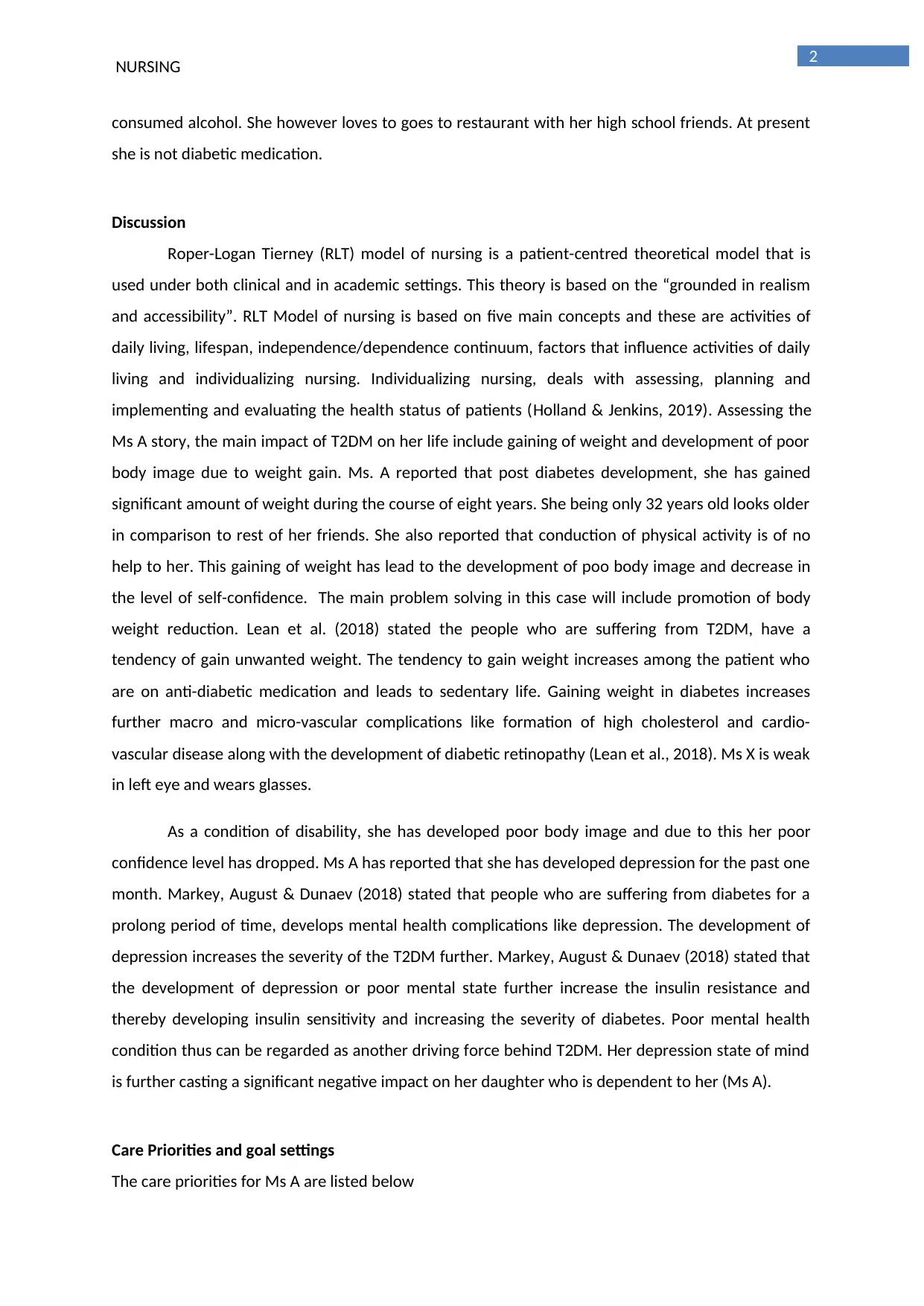
2
NURSING
consumed alcohol. She however loves to goes to restaurant with her high school friends. At present
she is not diabetic medication.
Discussion
Roper-Logan Tierney (RLT) model of nursing is a patient-centred theoretical model that is
used under both clinical and in academic settings. This theory is based on the “grounded in realism
and accessibility”. RLT Model of nursing is based on five main concepts and these are activities of
daily living, lifespan, independence/dependence continuum, factors that influence activities of daily
living and individualizing nursing. Individualizing nursing, deals with assessing, planning and
implementing and evaluating the health status of patients (Holland & Jenkins, 2019). Assessing the
Ms A story, the main impact of T2DM on her life include gaining of weight and development of poor
body image due to weight gain. Ms. A reported that post diabetes development, she has gained
significant amount of weight during the course of eight years. She being only 32 years old looks older
in comparison to rest of her friends. She also reported that conduction of physical activity is of no
help to her. This gaining of weight has lead to the development of poo body image and decrease in
the level of self-confidence. The main problem solving in this case will include promotion of body
weight reduction. Lean et al. (2018) stated the people who are suffering from T2DM, have a
tendency of gain unwanted weight. The tendency to gain weight increases among the patient who
are on anti-diabetic medication and leads to sedentary life. Gaining weight in diabetes increases
further macro and micro-vascular complications like formation of high cholesterol and cardio-
vascular disease along with the development of diabetic retinopathy (Lean et al., 2018). Ms X is weak
in left eye and wears glasses.
As a condition of disability, she has developed poor body image and due to this her poor
confidence level has dropped. Ms A has reported that she has developed depression for the past one
month. Markey, August & Dunaev (2018) stated that people who are suffering from diabetes for a
prolong period of time, develops mental health complications like depression. The development of
depression increases the severity of the T2DM further. Markey, August & Dunaev (2018) stated that
the development of depression or poor mental state further increase the insulin resistance and
thereby developing insulin sensitivity and increasing the severity of diabetes. Poor mental health
condition thus can be regarded as another driving force behind T2DM. Her depression state of mind
is further casting a significant negative impact on her daughter who is dependent to her (Ms A).
Care Priorities and goal settings
The care priorities for Ms A are listed below
NURSING
consumed alcohol. She however loves to goes to restaurant with her high school friends. At present
she is not diabetic medication.
Discussion
Roper-Logan Tierney (RLT) model of nursing is a patient-centred theoretical model that is
used under both clinical and in academic settings. This theory is based on the “grounded in realism
and accessibility”. RLT Model of nursing is based on five main concepts and these are activities of
daily living, lifespan, independence/dependence continuum, factors that influence activities of daily
living and individualizing nursing. Individualizing nursing, deals with assessing, planning and
implementing and evaluating the health status of patients (Holland & Jenkins, 2019). Assessing the
Ms A story, the main impact of T2DM on her life include gaining of weight and development of poor
body image due to weight gain. Ms. A reported that post diabetes development, she has gained
significant amount of weight during the course of eight years. She being only 32 years old looks older
in comparison to rest of her friends. She also reported that conduction of physical activity is of no
help to her. This gaining of weight has lead to the development of poo body image and decrease in
the level of self-confidence. The main problem solving in this case will include promotion of body
weight reduction. Lean et al. (2018) stated the people who are suffering from T2DM, have a
tendency of gain unwanted weight. The tendency to gain weight increases among the patient who
are on anti-diabetic medication and leads to sedentary life. Gaining weight in diabetes increases
further macro and micro-vascular complications like formation of high cholesterol and cardio-
vascular disease along with the development of diabetic retinopathy (Lean et al., 2018). Ms X is weak
in left eye and wears glasses.
As a condition of disability, she has developed poor body image and due to this her poor
confidence level has dropped. Ms A has reported that she has developed depression for the past one
month. Markey, August & Dunaev (2018) stated that people who are suffering from diabetes for a
prolong period of time, develops mental health complications like depression. The development of
depression increases the severity of the T2DM further. Markey, August & Dunaev (2018) stated that
the development of depression or poor mental state further increase the insulin resistance and
thereby developing insulin sensitivity and increasing the severity of diabetes. Poor mental health
condition thus can be regarded as another driving force behind T2DM. Her depression state of mind
is further casting a significant negative impact on her daughter who is dependent to her (Ms A).
Care Priorities and goal settings
The care priorities for Ms A are listed below
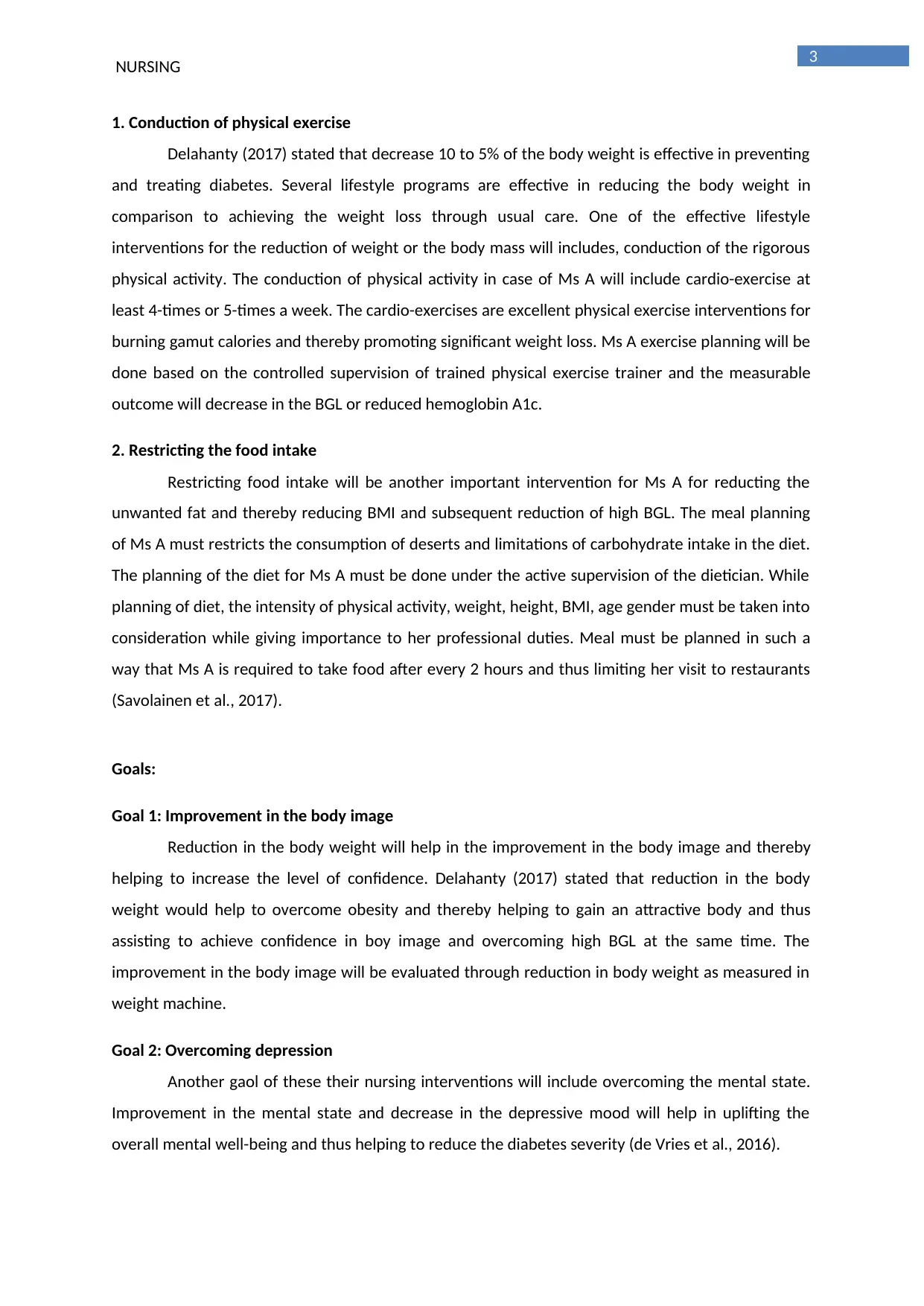
3
NURSING
1. Conduction of physical exercise
Delahanty (2017) stated that decrease 10 to 5% of the body weight is effective in preventing
and treating diabetes. Several lifestyle programs are effective in reducing the body weight in
comparison to achieving the weight loss through usual care. One of the effective lifestyle
interventions for the reduction of weight or the body mass will includes, conduction of the rigorous
physical activity. The conduction of physical activity in case of Ms A will include cardio-exercise at
least 4-times or 5-times a week. The cardio-exercises are excellent physical exercise interventions for
burning gamut calories and thereby promoting significant weight loss. Ms A exercise planning will be
done based on the controlled supervision of trained physical exercise trainer and the measurable
outcome will decrease in the BGL or reduced hemoglobin A1c.
2. Restricting the food intake
Restricting food intake will be another important intervention for Ms A for reducting the
unwanted fat and thereby reducing BMI and subsequent reduction of high BGL. The meal planning
of Ms A must restricts the consumption of deserts and limitations of carbohydrate intake in the diet.
The planning of the diet for Ms A must be done under the active supervision of the dietician. While
planning of diet, the intensity of physical activity, weight, height, BMI, age gender must be taken into
consideration while giving importance to her professional duties. Meal must be planned in such a
way that Ms A is required to take food after every 2 hours and thus limiting her visit to restaurants
(Savolainen et al., 2017).
Goals:
Goal 1: Improvement in the body image
Reduction in the body weight will help in the improvement in the body image and thereby
helping to increase the level of confidence. Delahanty (2017) stated that reduction in the body
weight would help to overcome obesity and thereby helping to gain an attractive body and thus
assisting to achieve confidence in boy image and overcoming high BGL at the same time. The
improvement in the body image will be evaluated through reduction in body weight as measured in
weight machine.
Goal 2: Overcoming depression
Another gaol of these their nursing interventions will include overcoming the mental state.
Improvement in the mental state and decrease in the depressive mood will help in uplifting the
overall mental well-being and thus helping to reduce the diabetes severity (de Vries et al., 2016).
NURSING
1. Conduction of physical exercise
Delahanty (2017) stated that decrease 10 to 5% of the body weight is effective in preventing
and treating diabetes. Several lifestyle programs are effective in reducing the body weight in
comparison to achieving the weight loss through usual care. One of the effective lifestyle
interventions for the reduction of weight or the body mass will includes, conduction of the rigorous
physical activity. The conduction of physical activity in case of Ms A will include cardio-exercise at
least 4-times or 5-times a week. The cardio-exercises are excellent physical exercise interventions for
burning gamut calories and thereby promoting significant weight loss. Ms A exercise planning will be
done based on the controlled supervision of trained physical exercise trainer and the measurable
outcome will decrease in the BGL or reduced hemoglobin A1c.
2. Restricting the food intake
Restricting food intake will be another important intervention for Ms A for reducting the
unwanted fat and thereby reducing BMI and subsequent reduction of high BGL. The meal planning
of Ms A must restricts the consumption of deserts and limitations of carbohydrate intake in the diet.
The planning of the diet for Ms A must be done under the active supervision of the dietician. While
planning of diet, the intensity of physical activity, weight, height, BMI, age gender must be taken into
consideration while giving importance to her professional duties. Meal must be planned in such a
way that Ms A is required to take food after every 2 hours and thus limiting her visit to restaurants
(Savolainen et al., 2017).
Goals:
Goal 1: Improvement in the body image
Reduction in the body weight will help in the improvement in the body image and thereby
helping to increase the level of confidence. Delahanty (2017) stated that reduction in the body
weight would help to overcome obesity and thereby helping to gain an attractive body and thus
assisting to achieve confidence in boy image and overcoming high BGL at the same time. The
improvement in the body image will be evaluated through reduction in body weight as measured in
weight machine.
Goal 2: Overcoming depression
Another gaol of these their nursing interventions will include overcoming the mental state.
Improvement in the mental state and decrease in the depressive mood will help in uplifting the
overall mental well-being and thus helping to reduce the diabetes severity (de Vries et al., 2016).
Secure Best Marks with AI Grader
Need help grading? Try our AI Grader for instant feedback on your assignments.
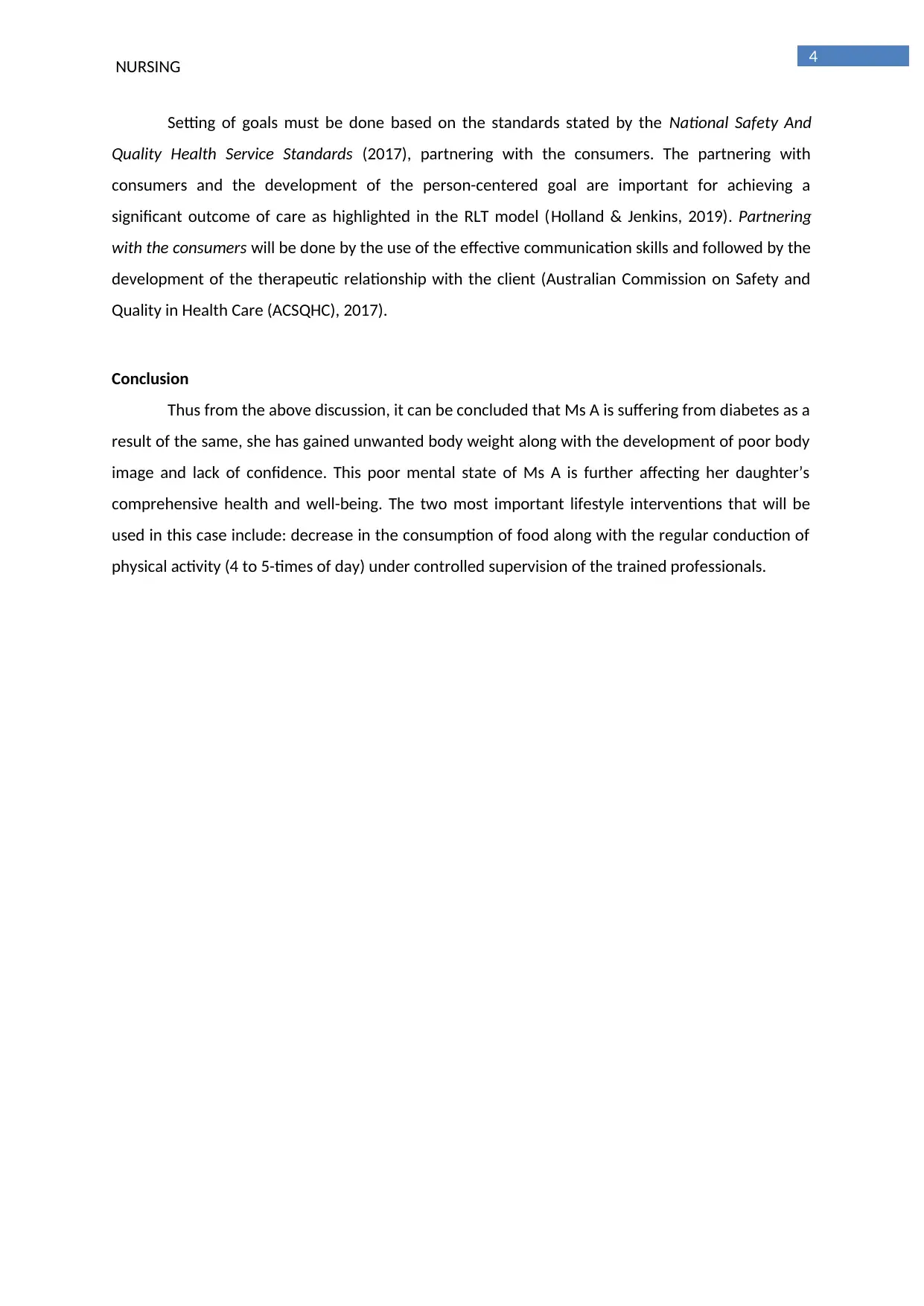
4
NURSING
Setting of goals must be done based on the standards stated by the National Safety And
Quality Health Service Standards (2017), partnering with the consumers. The partnering with
consumers and the development of the person-centered goal are important for achieving a
significant outcome of care as highlighted in the RLT model (Holland & Jenkins, 2019). Partnering
with the consumers will be done by the use of the effective communication skills and followed by the
development of the therapeutic relationship with the client (Australian Commission on Safety and
Quality in Health Care (ACSQHC), 2017).
Conclusion
Thus from the above discussion, it can be concluded that Ms A is suffering from diabetes as a
result of the same, she has gained unwanted body weight along with the development of poor body
image and lack of confidence. This poor mental state of Ms A is further affecting her daughter’s
comprehensive health and well-being. The two most important lifestyle interventions that will be
used in this case include: decrease in the consumption of food along with the regular conduction of
physical activity (4 to 5-times of day) under controlled supervision of the trained professionals.
NURSING
Setting of goals must be done based on the standards stated by the National Safety And
Quality Health Service Standards (2017), partnering with the consumers. The partnering with
consumers and the development of the person-centered goal are important for achieving a
significant outcome of care as highlighted in the RLT model (Holland & Jenkins, 2019). Partnering
with the consumers will be done by the use of the effective communication skills and followed by the
development of the therapeutic relationship with the client (Australian Commission on Safety and
Quality in Health Care (ACSQHC), 2017).
Conclusion
Thus from the above discussion, it can be concluded that Ms A is suffering from diabetes as a
result of the same, she has gained unwanted body weight along with the development of poor body
image and lack of confidence. This poor mental state of Ms A is further affecting her daughter’s
comprehensive health and well-being. The two most important lifestyle interventions that will be
used in this case include: decrease in the consumption of food along with the regular conduction of
physical activity (4 to 5-times of day) under controlled supervision of the trained professionals.

5
NURSING
References
Alkhatib, A., & Tuomilehto, J. (2019). Lifestyle diabetes prevention. In Encyclopedia of Endocrine
Diseases (pp. 148-159). Elsevier. https://research.tees.ac.uk/en/publications/lifestyle-
diabetes-prevention
Australian Commission on Safety and Quality in Health Care (ACSQHC). (2017). National Safety And
Quality Health Service Standards (2nd Ed.). Sydney, Aust.: Author. Retrieved from
https://www.safetyandquality.gov.au/our-work/assessmentto-the- nsqhs-standards
Australian Government Department of Health. (2019). Chronic conditions. Access date: 20th April
2020. Retrieved from: https://www.health.gov.au/health-topics/chronic-conditions
de Vries, M., Heather, F., Boyle, K. B., Rooney, K., & Bogner, H. R. (2016). Diabetes and depression
care: a randomized controlled pilot trial. American journal of health behavior, 40(4), 503-
513. DOI: https://doi.org/10.5993/AJHB.40.4.12
Delahanty, L. M. (2017). Weight loss in the prevention and treatment of diabetes. Preventive
medicine, 104, 120-123. https://doi.org/10.1016/j.ypmed.2017.07.022
Diabetes Australia. (2019). Diabetes. Access date: 20th April 2020. Retrieved from:
https://www.diabetesaustralia.com.au/
Gayathri, R., Ruchi, V., & Mohan, V. (2017). Impact of nutrition transition and resulting morbidities
on economic and human development. Current diabetes reviews, 13(5), 452-460.
DOI: https://doi.org/10.2174/1573399812666160901095534
Holland, K., & Jenkins, J. (Eds.). (2019). Applying the Roper-Logan-Tierney Model in Practice-E-Book.
Elsevier Health Sciences.
Jendle, J. H., & Riddell, M. C. (2019). Physical Exercise and Diabetes-Beneficial or Leading to an
Increased Risk?. Frontiers in Endocrinology, 10, 860.
https://doi.org/10.3389/fendo.2019.00860
Lean, M. E., Leslie, W. S., Barnes, A. C., Brosnahan, N., Thom, G., McCombie, L., ... & Rodrigues, A. M.
(2018). Primary care-led weight management for remission of type 2 diabetes (DiRECT): an
open-label, cluster-randomised trial. The Lancet, 391(10120), 541-551.
https://doi.org/10.1016/S0140-6736(17)33102-1
NURSING
References
Alkhatib, A., & Tuomilehto, J. (2019). Lifestyle diabetes prevention. In Encyclopedia of Endocrine
Diseases (pp. 148-159). Elsevier. https://research.tees.ac.uk/en/publications/lifestyle-
diabetes-prevention
Australian Commission on Safety and Quality in Health Care (ACSQHC). (2017). National Safety And
Quality Health Service Standards (2nd Ed.). Sydney, Aust.: Author. Retrieved from
https://www.safetyandquality.gov.au/our-work/assessmentto-the- nsqhs-standards
Australian Government Department of Health. (2019). Chronic conditions. Access date: 20th April
2020. Retrieved from: https://www.health.gov.au/health-topics/chronic-conditions
de Vries, M., Heather, F., Boyle, K. B., Rooney, K., & Bogner, H. R. (2016). Diabetes and depression
care: a randomized controlled pilot trial. American journal of health behavior, 40(4), 503-
513. DOI: https://doi.org/10.5993/AJHB.40.4.12
Delahanty, L. M. (2017). Weight loss in the prevention and treatment of diabetes. Preventive
medicine, 104, 120-123. https://doi.org/10.1016/j.ypmed.2017.07.022
Diabetes Australia. (2019). Diabetes. Access date: 20th April 2020. Retrieved from:
https://www.diabetesaustralia.com.au/
Gayathri, R., Ruchi, V., & Mohan, V. (2017). Impact of nutrition transition and resulting morbidities
on economic and human development. Current diabetes reviews, 13(5), 452-460.
DOI: https://doi.org/10.2174/1573399812666160901095534
Holland, K., & Jenkins, J. (Eds.). (2019). Applying the Roper-Logan-Tierney Model in Practice-E-Book.
Elsevier Health Sciences.
Jendle, J. H., & Riddell, M. C. (2019). Physical Exercise and Diabetes-Beneficial or Leading to an
Increased Risk?. Frontiers in Endocrinology, 10, 860.
https://doi.org/10.3389/fendo.2019.00860
Lean, M. E., Leslie, W. S., Barnes, A. C., Brosnahan, N., Thom, G., McCombie, L., ... & Rodrigues, A. M.
(2018). Primary care-led weight management for remission of type 2 diabetes (DiRECT): an
open-label, cluster-randomised trial. The Lancet, 391(10120), 541-551.
https://doi.org/10.1016/S0140-6736(17)33102-1
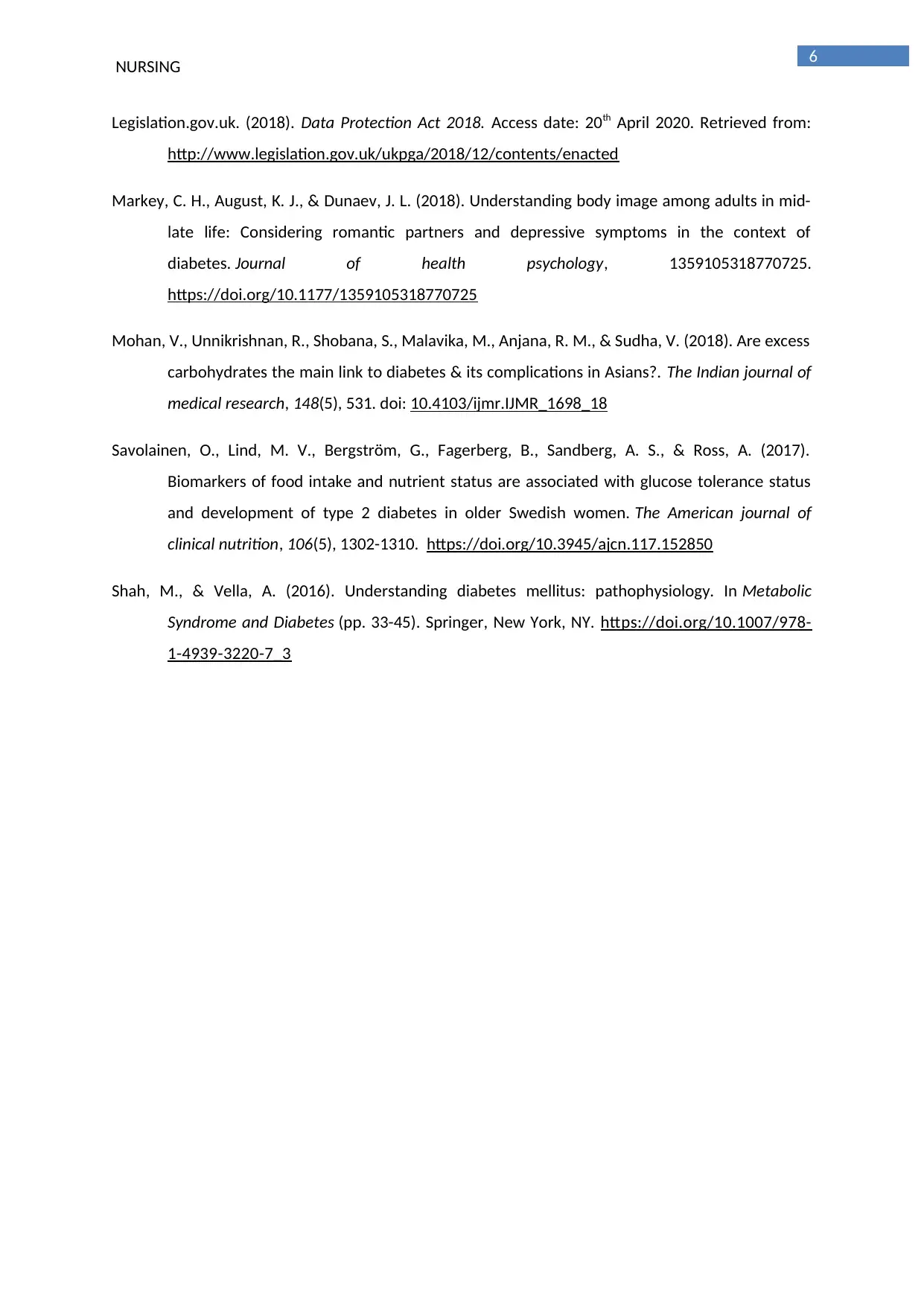
6
NURSING
Legislation.gov.uk. (2018). Data Protection Act 2018. Access date: 20th April 2020. Retrieved from:
http://www.legislation.gov.uk/ukpga/2018/12/contents/enacted
Markey, C. H., August, K. J., & Dunaev, J. L. (2018). Understanding body image among adults in mid-
late life: Considering romantic partners and depressive symptoms in the context of
diabetes. Journal of health psychology, 1359105318770725.
https://doi.org/10.1177/1359105318770725
Mohan, V., Unnikrishnan, R., Shobana, S., Malavika, M., Anjana, R. M., & Sudha, V. (2018). Are excess
carbohydrates the main link to diabetes & its complications in Asians?. The Indian journal of
medical research, 148(5), 531. doi: 10.4103/ijmr.IJMR_1698_18
Savolainen, O., Lind, M. V., Bergström, G., Fagerberg, B., Sandberg, A. S., & Ross, A. (2017).
Biomarkers of food intake and nutrient status are associated with glucose tolerance status
and development of type 2 diabetes in older Swedish women. The American journal of
clinical nutrition, 106(5), 1302-1310. https://doi.org/10.3945/ajcn.117.152850
Shah, M., & Vella, A. (2016). Understanding diabetes mellitus: pathophysiology. In Metabolic
Syndrome and Diabetes (pp. 33-45). Springer, New York, NY. https://doi.org/10.1007/978-
1-4939-3220-7_3
NURSING
Legislation.gov.uk. (2018). Data Protection Act 2018. Access date: 20th April 2020. Retrieved from:
http://www.legislation.gov.uk/ukpga/2018/12/contents/enacted
Markey, C. H., August, K. J., & Dunaev, J. L. (2018). Understanding body image among adults in mid-
late life: Considering romantic partners and depressive symptoms in the context of
diabetes. Journal of health psychology, 1359105318770725.
https://doi.org/10.1177/1359105318770725
Mohan, V., Unnikrishnan, R., Shobana, S., Malavika, M., Anjana, R. M., & Sudha, V. (2018). Are excess
carbohydrates the main link to diabetes & its complications in Asians?. The Indian journal of
medical research, 148(5), 531. doi: 10.4103/ijmr.IJMR_1698_18
Savolainen, O., Lind, M. V., Bergström, G., Fagerberg, B., Sandberg, A. S., & Ross, A. (2017).
Biomarkers of food intake and nutrient status are associated with glucose tolerance status
and development of type 2 diabetes in older Swedish women. The American journal of
clinical nutrition, 106(5), 1302-1310. https://doi.org/10.3945/ajcn.117.152850
Shah, M., & Vella, A. (2016). Understanding diabetes mellitus: pathophysiology. In Metabolic
Syndrome and Diabetes (pp. 33-45). Springer, New York, NY. https://doi.org/10.1007/978-
1-4939-3220-7_3
1 out of 7
Related Documents
Your All-in-One AI-Powered Toolkit for Academic Success.
+13062052269
info@desklib.com
Available 24*7 on WhatsApp / Email
![[object Object]](/_next/static/media/star-bottom.7253800d.svg)
Unlock your academic potential
© 2024 | Zucol Services PVT LTD | All rights reserved.





